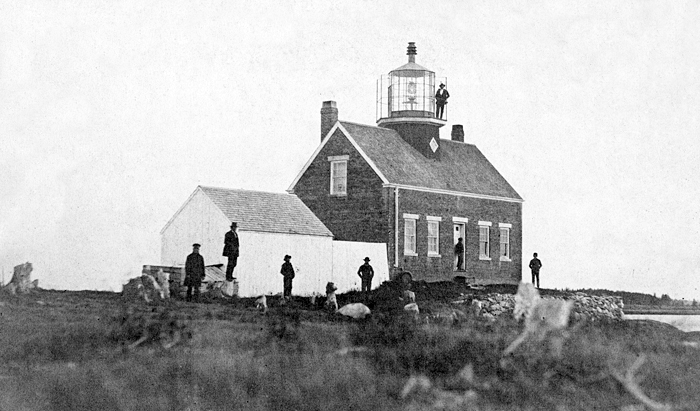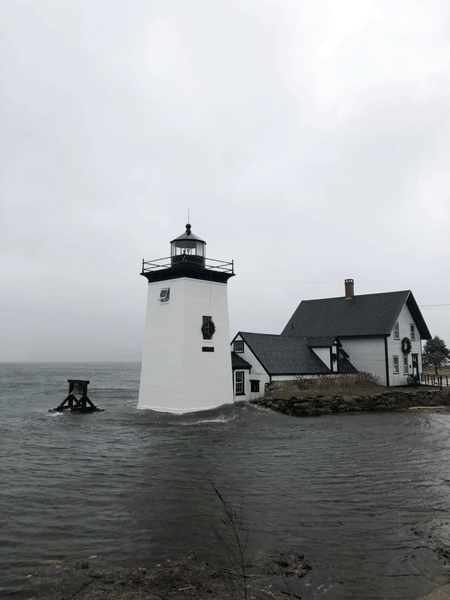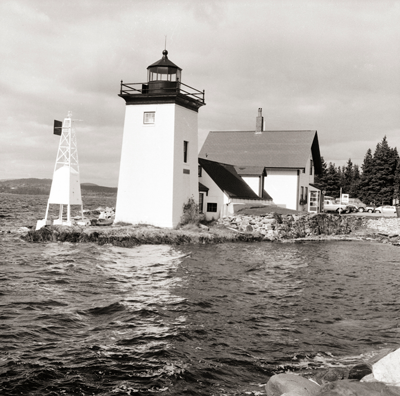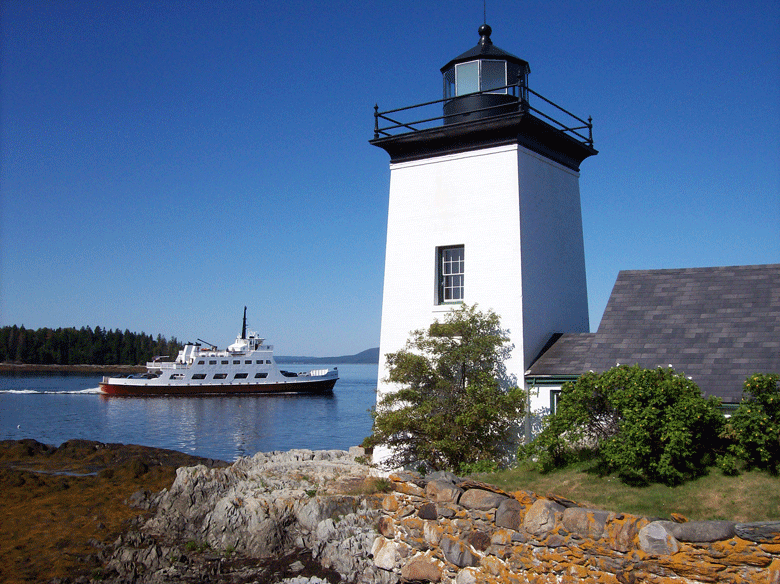From the top deck of the Margaret Chase Smith ferry, the first thing that can be seen approaching Islesboro is the Grindle Point Lighthouse. Standing at the northern edge of Gilkey Harbor and next to the ferry pen, the lighthouse greets residents and visitors alike to the island.

At first glance, the tower is unassuming. It is square and short in stature, connected by a pitched roof ell to a keeper’s house that appears untouched by time. But in fact, it presents a passageway to the past, out of the now and into the thickets of the culture and history of the island.
What the story of the Grindle Point Light station reveals is a space that has been fought for and preserved by the residents of Islesboro. Time and time again, it is a symbol of community and a vision of the island’s identity.
The Grindle Point lighthouse was originally built in 1850 after the first significant steamboat route to Islesboro was established…
The Grindle Point Lighthouse was originally built in 1850 after the first significant steamboat route to Islesboro was established and marine traffic in the surrounding waters increased. The original lighthouse included a single-story keeper’s house with a lantern room cupola perched on its roof. The station was built on land purchased from Francis Grindle, who later served as keeper, for $105. It was the 37th lighthouse to be built in Maine.

In 1875, after several keepers had passed in and out of service on the point and kept the oil burning brightly, it became clear the structure was in such bad condition it was advised to rebuild it rather than repair. A year later, the brick tower that stands today was erected on the limestone ledge and a new two-story keeper’s house was built beside it.
The roof of the original structure was lowered to form the ell connecting the house to the tower, making it the only lighthouse to include part of its original structure in its current design.
Even as the tides of island residents shifted in and out with changing seasons, a beam of light circled the harbor each night, guiding mariners through rocky and uncertain seas. In 1938, as the Great Depression tightened its grip on the American economy and diminished marine traffic, the Coast Guard decommissioned the station.
The last keeper, William C. Dodge, and his collie named Tray, who had learned to sound the station’s fog bell, packed their belongings and abandoned the light. The Fresnel lens was removed and dumped into the ocean. In its place, an 18-foot metal framed skeleton tower was positioned on the ledge and flashed its unattended acetylene light into the darkness. The light station was sold to the town for $1,200 and turned into what is now The Sailors’ Memorial Museum.
What is the value of lighthouses? With GPS, electric running lights, and well-tested charts mapping precise coastlines and ledges, lighthouses are no longer necessary navigational aids.
Since the first lighthouse was built at the entrance to the Greek city of Alexandria along the Nile Delta in 297 B.C., they have been markers of human presence on shorelines around the world. They are loved for their liminality and the space they inhabit between land and sea, light and darkness.
Lighthouses provide a place in which coastal residents can claim their inhabitance of the waterfront.

Fifty years after the Grindle Point Lighthouse went out of service, the Islesboro Select Board and members of the community lobbied the Coast Guard to bring the light back. On Nov. 4, 1987, a crowd of 300 gathered at Grindle Point under stormy gray skies to see Capt. John Williams, commanding officer of Coast Guard Group Southwest Harbor, remove the skeleton and install a solar powered beacon back into the tower. The light has been active ever since.
Now the future of the Grindle Point Lighthouse is threatened by a much a larger and less predictable kind of change: Our current climate crisis. As sea levels rise due to thermal expansion and melting land ice, including the Antarctica and Greenland icesheets, lighthouses around the world are vulnerable.
With the Dec. 23 storm this past winter, the Grindle Point Lighthouse, which sits barely a foot above current sea level, experienced significant flooding at the base of the tower and in the original foundation. Once again, the lighthouse is caught in liminality. With many questions arising about the future of human inhabitance of the waterfront, its serves as a new kind of beacon: a warning sign of our changing coastline. Will it survive another 50 years or be washed away with the higher tides?
On July 1, the Grindle Point Lighthouse Sailors Memorial Museum will reopen to the public with new exhibits on the history of mariners on Islesboro and in Penobscot Bay. The museum will host an art installation created by Islesboro Central School Students and visiting artist, Pamela Moulton, drawing attention to sea level rise.
Olivia Lenfestey is an Island Fellow through the Island Institute, publisher of The Working Waterfront, working with the Grindle Point Lighthouse Museum and Islesboro’s Sea Level Rise Committee. She grew up in Santa Fe, N.M. and graduated from Pitzer College in Claremont, Calif., where she studied English, creative writing, and environmental analysis.






